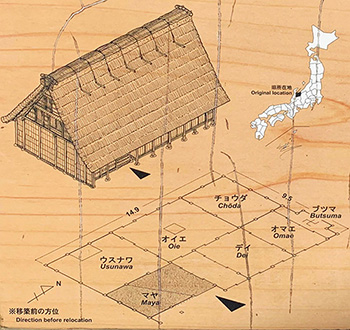


蓮如の陰謀、そして家水道などナゾ多き五箇山合掌の家。
見学時にはいろいろ気付かないことが多いことも残念ながら事実。
基本的には見て感じたことが優先事項なのだけれど、
細部を調査していくと、見学時の体験にまったく違う見方も生まれる。
蓮如さんの一件など伝承を事前に知り得ていれば、
まったく違うポイントからの見学もあり得るのだと思う。
「そういうことだったのか」と深い納得が得られるのですね。
コロナ禍で撮影し貯めていた古民家住宅追体験ですが、
しかしこのような新発見が得られ新鮮な気付きができてウレシイ。
住宅建築というのはどっちかというと理数的な「工学」主体ですが
しかし人間社会には歴史があり社会的関係性も大きく関わる。
いわば「人文系」の情報もそこから大きく浮かび上がってくる。
基本的には数学的把握の世界だけれど、その正確性に立脚して
いわば情念的な世界も惹起されてくる。
基本的には人間普遍的な環境性を最重視して住宅性能的見方、
フィルターを通して見返してみていますが、
先人たちが正面から「いごこち」に向き合って家づくりに努力してきたことが
見えてくるものがあります。地域気候と対話しながらの家づくりですね。
わたしはReplanという住宅雑誌をライフワークにしてきているのですが、
現代住宅だけではなく、古民家でも同様の手法で解析できることが、
だんだんとわかってくる気がしています。
古民家とは言っても先人もまた同胞。感受性に於いてそう違いはない。
塩硝という火薬原料の生産が幕府中央に対しては厳に秘密で、
加賀藩前田家の軍事上の最重要物資であっただろうことはあきらか。
その製造上のプロセスでは大量の水が不可欠だったようで、
昨日紹介した「宅内水道」施設はそうした生産工程に欠かせなかったようです。
以下読者のNさんからのコメント要旨。
〜五箇山は和紙の産地。和紙漉きには水船を使います。そのような作業を
冬でも屋内で出来るようにしたのがウスナワ(ウスナカとも)だったのでは。
この紙作り(12世紀あたりから?)の作業環境を16世紀から煙硝作りにも
流用したと想像できる。
重要な作業であった煙硝作りも大量の水や薪を使う。
土から硝石分を抽出し何度か再結晶させて純度を上げていく作業にも
ウスナワは役立ったものと思います。〜
という注目すべき投稿をいただきました。高校時代以来の付き合い。
ほぼ確実性の高い推論だろうと受け止めさせていただきました。感謝。
幕府隠密がこの地に潜り込んだとしてやはり水道には目をつけるでしょうね。
ただ、見学時にこうした情報までは知り得なかったので、もうひとつ
「床高」がこの塩硝生産に関係がある、と言うポイントは記憶にない。
外観写真でなにかのヒントがと思うのですが、いまのところ確定できません。
まぁしかしこういう「行きつ戻りつ」もまた、先人からの試練か(笑)。
コロナ禍が落ち着いたら、再度川崎の復元住宅を再訪したい。
写真は手前側に肥料小屋兼用の外部トイレと本屋。
それと本屋の入口から内部を覗いた位置からのアングル。
やはり「床高」を確認することはできませんが、こういう意図であります。
English version⬇
[Gassho-zukuri is also a form of exploring a good life / Japanese good house ㉚-4]
Rennyo’s plot, and Gokayama Gassho’s house with many mysteries such as water supply.
Unfortunately, it is a fact that many people do not notice during the tour.
Basically, what I see and feel is a priority,
Investigating the details will give you a completely different perspective on your experience during the tour.
If you know the folklore such as Rennyo’s case in advance,
I think it is possible to visit from a completely different point.
You can get a deep conviction, “Is that the case?”
It is a re-experience of an old folk house that was taken and saved in Corona
However, such a new discovery was made and I was able to realize something fresh.
Residential architecture is more of a mathematical “engineering” subject,
However, human society has a history and social relationships are greatly involved.
So to speak, “humanities” information also emerges from there.
It’s basically a world of mathematical understanding, but based on its accuracy
So to speak, a passionate world is also evoked.
Basically, the view of housing performance with the highest priority on the universal environmentality of human beings,
I’m looking back through the filter,
The fact that the ancestors have made efforts to build a house by facing “Igokochi” from the front
There is something you can see. It’s about building a house while interacting with the local climate.
I’ve been using a housing magazine called Replan as my lifework.
It is possible to analyze not only modern houses but also old houses by the same method.
I feel like I’m gradually getting to know it.
Even though it is an old folk house, its predecessors are also compatriots and there is no difference in sensitivity.
The production of saltpeter, a raw material for gunpowder, is strictly secret to the central government of the Shogunate.
It is clear that it was probably the most important military material of the Maeda clan of the Kaga domain.
It seems that a large amount of water was indispensable in the manufacturing process.
It seems that the “home water supply” facility introduced yesterday was indispensable for such a production process.
Below is a summary of comments from reader N.
~ Gokayama is a production center of Japanese paper. A water boat is used to make Japanese paper. Such work
I think it was Usnawa (also known as Usnaka) that made it possible to do it indoors even in winter.
The working environment for making this paper (from around the 12th century?)
I can imagine that it was diverted.
Making smoked saltpeter, which was an important task, also uses a large amount of water and firewood.
Also for work to extract saltpeter from soil and recrystallize it several times to increase its purity
I think Usnawa was useful. ~
I received a noteworthy post. I’ve been dating since high school.
I took it as an inference with almost certainty. Thanks.
Even if the shogunate covertness sneaks into this area, you will still pay attention to the water supply.
However, I didn’t know this information at the time of the tour, so there is one more thing.
I don’t remember the point that “floor height” is related to this saltpeter production.
I think there is some hint in the exterior photo, but I can’t confirm it so far.
Well, however, this kind of “going back and forth” is also a test from our predecessors (laughs).
When the corona wreck has settled down, I would like to revisit the restored house in Kawasaki.
The photo shows an external toilet and bookstore that doubles as a fertilizer hut on the front side.
And the angle from the position where I looked inside from the entrance of the bookstore.
After all, it is not possible to confirm the “floor height”, but this is the intention.
Posted on 5月 14th, 2021 by 三木 奎吾
Filed under: 住宅マーケティング, 日本社会・文化研究







コメントを投稿
「※誹謗中傷や、悪意のある書き込み、営利目的などのコメントを防ぐために、投稿された全てのコメントは一時的に保留されますのでご了承ください。」
You must be logged in to post a comment.